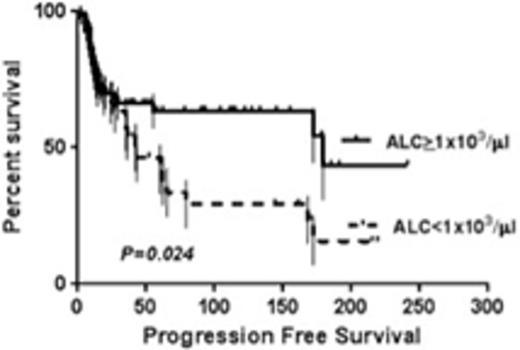Abstract

Introduction: Patients with Hodgkin lymphoma (HL) have excellent response to current chemotherapy, however, up to 20% may have relapsed/refractory disease. Lymphocytopenia at diagnosis has been found to be predictive of survival in patients with advanced stage HL. An ALC of <600/μlat diagnosis as part of the Hasenclever predictive score is associated with a poorer prognosis. Furthermore, lymphocyte count at the time of apheresis and at day 15 after autologous SCT has been found to be predictive of survival in patients of HL. ALC is considered a surrogate indicator for the tumor microenvironment as well as immune recovery post treatment. There are no large studies evaluating the clinical significance of ALC recovery in patients with HL during initial chemotherapy treatment. In this study, we evaluated the role of lymphocyte recovery during and after standard chemotherapy in patients with HL.
Patients and Methods: We analyzed 183 patients with Classical Hodgkin lymphoma treated at our institution between 1996 and 2014 following IRB approval. Complete data was available for 115 patients. We evaluated the absolute lymphocyte count at diagnosis, interim staging (after 2 cycles, Òinterim ALCÓ), at time of completion of chemotherapy and at 6 weeks and 3 months post completion of chemotherapy. Patients were categorized into two groups based on ALC where lymphocytopenia was defined as an ALC of <1x103/µl for adults based on standard criteria. Differences between the two groups were analyzed using Chi- square and t -Student tests. Statistical significance was set at P <0.05. Kaplan Meier method was used to calculate the Progression-free survival (PFS) and overall survival (OS). Log-rank test was used to determine the differences in survival. Statistical analysis was performed using SPSS.22 software.
Results: The median age of patients was 31 years (yrs.) (range: 17-76 yrs.) and 53% of patients were male. 100% patients had an ECOG status of 0-1. 48% patients presented with B symptoms, 42% had advanced stage disease (Stage III and IV) and 22% had bulky disease (defined as a mass > 10 cm or mediastinal mass >1/3 of diameter of thorax at T5-T6). In terms of histology, 68% patients had classical nodular sclerosis HL, 19% syncytial variant of nodular sclerosis HL, 8% mixed cellularity HL and 5% Classical HL (NOS). 90% patients received ABVD as their initial chemotherapy, 2% received Stanford V and 1% received MOPP. The remaining patients were treated on a clinical trial. In the analysis of the 115 patients for whom the lymphocyte data was available, at a median follow up of 40 months, 57% in the ALC <1x103/µl group versus 66% in the ALC >1x103/µlgroup had not progressed. The median overall survival was not reached in the two groups. In the multivariate analysis, for PFS, interim ALC predicted survival independent of the interim staging response. The ALC at the time of interim staging scan (interim ALC) was associated with a significantly superior PFS in the group with ALC>1x103/µl(HR=4.16, 95% CI 2.37 to 7.28, P=0.024). There was no difference in overall survival between the groups (Fig. 1&2,P=0.28). For ALC at other time points, no statistically significant differences in PFS or OS were found in the two groups based on ALC at diagnosis, completion of therapy, six weeks and three months post therapy.
Discussion: In summary, our results suggest that for patients across all stages and histopathologic subtypes of classical HL receiving first line chemotherapy, interim ALC >1x103/µl (after 2 cycles) is associated with a superior PFS as compared with ALC <1 x103/µl and this is independent of the interim staging response. This did not translate into a difference in OS. Further studies are underway to determine the role of immune effector cells in the context of newer therapeutic agents.
Reddy:Gilead: Other: Speaker; Seattle Genetics: Consultancy; ImmunoGen: Consultancy; PCYC: Consultancy; Celgene: Consultancy, Research Funding.
Author notes
Asterisk with author names denotes non-ASH members.

This icon denotes a clinically relevant abstract



This feature is available to Subscribers Only
Sign In or Create an Account Close Modal